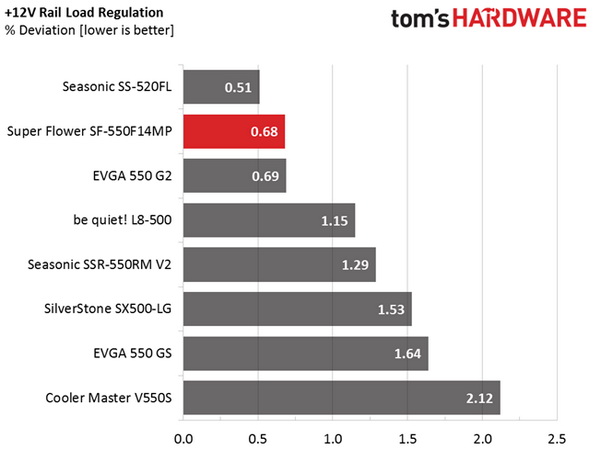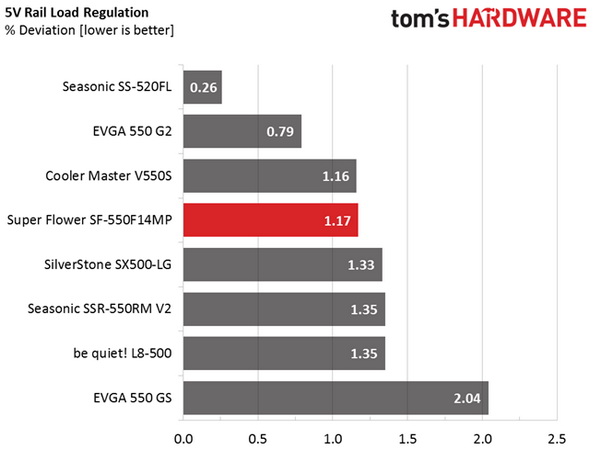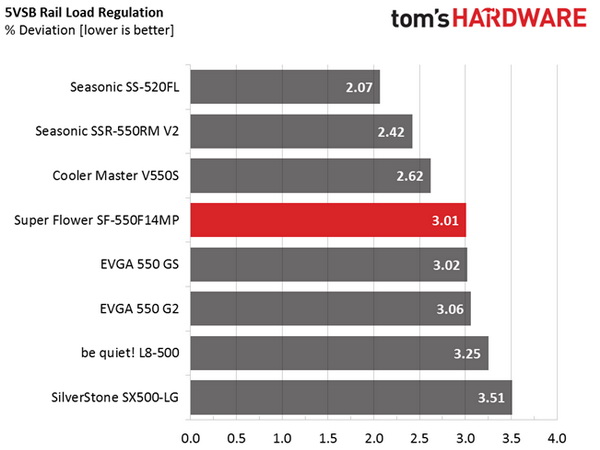Super Flower Leadex Platinum 550W PSU Review
Super Flower responds to the high demand for low-capacity and highly efficient PSUs with the release of its Leadex Platinum with 550 W max power. This unit packs high performance, silent operation and Platinum efficiency.
Why you can trust Tom's Hardware
Load Regulation, Hold-Up Time And Inrush Current
To learn more about our PSU tests and methodology, please check out How We Test Power Supply Units.
Primary Rails And 5VSB Load Regulation
Load Regulation testing is detailed here.








Hold-Up Time
Our hold-up time tests are described in detail here.


The registered hold-up time didn't reach the 16 ms mark and so the PSU failed this test. Super Flower should have used a larger bulk cap; although a larger bulk cap would have affected the unit's efficiency and increased the production cost.
Inrush Current
For details on our inrush current testing, please click here.


The inrush current that our power analyzer recorded was a little higher than average, but it shouldn't cause any issues for your home's electrical system.
Load Regulation And Efficiency Measurements
The first set of tests reveals the stability of the voltage rails and the PSU's efficiency. The applied load equals (approximately) 10 to 110 percent of the maximum load the supply can handle, in increments of 10 percentage points.
Get Tom's Hardware's best news and in-depth reviews, straight to your inbox.
We conducted two additional tests. During the first, we stressed the two minor rails (5V and 3.3V) with a high load, while the load at +12V was only 0.10A. This test reveals whether a PSU is Haswell-ready or not. In the second test, we determined the maximum load the +12V rail could handle with minimal load on the minor rails.
| Test | 12V | 5V | 3.3V | 5VSB | Power(DC/AC) | Efficiency | Fan Speed | Fan Noise | Temp(In/Out) | PF/AC Volts |
|---|---|---|---|---|---|---|---|---|---|---|
| 1 | 2.710A | 1.983A | 1.999A | 0.979A | 54.73W | 86.18% | 0 RPM | 0 dBA | 46.86°C | 0.947 |
| 12.235V | 5.048V | 3.298V | 5.081V | 63.51W | 41.88°C | 115.1V | ||||
| 2 | 6.453A | 2.969A | 3.004A | 1.180A | 109.74W | 89.69% | 0 RPM | 0 dBA | 48.04°C | 0.967 |
| 12.227V | 5.042V | 3.293V | 5.069V | 122.35W | 42.74°C | 115.1V | ||||
| 3 | 10.539A | 3.477A | 3.522A | 1.382A | 164.86W | 90.97% | 0 RPM | 0 dBA | 49.71°C | 0.980 |
| 12.219V | 5.036V | 3.290V | 5.055V | 181.23W | 44.03°C | 115.1V | ||||
| 4 | 14.625A | 3.973A | 4.015A | 1.585A | 219.78W | 91.37% | 0 RPM | 0 dBA | 51.74°C | 0.986 |
| 12.213V | 5.031V | 3.285V | 5.042V | 240.54W | 45.61°C | 115.1V | ||||
| 5 | 18.372A | 4.972A | 5.029A | 1.788A | 274.73W | 91.24% | 0 RPM | 0 dBA | 53.56°C | 0.990 |
| 12.207V | 5.025V | 3.279V | 5.028V | 301.10W | 47.02°C | 115.1V | ||||
| 6 | 22.131A | 5.975A | 6.045A | 1.995A | 329.72W | 90.84% | 650 RPM | 27.5 dBA | 41.81°C | 0.992 |
| 12.198V | 5.018V | 3.274V | 5.010V | 362.96W | 49.88°C | 115.1V | ||||
| 7 | 25.920A | 6.987A | 7.061A | 2.200A | 384.72W | 90.28% | 650 RPM | 27.5 dBA | 42.96°C | 0.993 |
| 12.177V | 5.012V | 3.269V | 4.996V | 426.16W | 52.07°C | 115.1V | ||||
| 8 | 29.696A | 7.991A | 8.085A | 2.406A | 439.62W | 89.70% | 650 RPM | 27.5 dBA | 43.20°C | 0.994 |
| 12.165V | 5.005V | 3.264V | 4.980V | 490.11W | 52.71°C | 115.1V | ||||
| 9 | 33.895A | 8.497A | 8.618A | 2.410A | 494.73W | 89.13% | 650 RPM | 27.5 dBA | 43.85°C | 0.994 |
| 12.160V | 5.000V | 3.260V | 4.975V | 555.08W | 53.81°C | 115.1V | ||||
| 10 | 38.052A | 9.014A | 9.122A | 2.515A | 549.59W | 88.40% | 1000 RPM | 35.6 dBA | 46.14°C | 0.994 |
| 12.152V | 4.993V | 3.255V | 4.964V | 621.68W | 56.58°C | 115.1V | ||||
| 11 | 42.616A | 9.027A | 9.134A | 2.518A | 604.57W | 87.81% | 1000 RPM | 35.6 dBA | 47.52°C | 0.994 |
| 12.140V | 4.989V | 3.251V | 4.958V | 688.47W | 58.21°C | 115.1V | ||||
| CL1 | 0.099A | 12.009A | 12.005A | 0.003A | 100.84W | 83.79% | 650 RPM | 27.5 dBA | 45.02°C | 0.966 |
| 12.239V | 5.016V | 3.280V | 5.093V | 120.35W | 53.21°C | 115.1V | ||||
| CL2 | 45.785A | 1.003A | 1.003A | 1.001A | 569.32W | 89.22% | 1000 RPM | 35.6 dBA | 47.09°C | 0.994 |
| 12.143V | 5.013V | 3.268V | 5.041V | 638.08W | 57.72°C | 115.1V |
Load regulation on the +12V rail was pretty tight; on the 5V and 3.3V rails it was also at good levels. At 5VSB the overall deviation reached 3 percent, a rather low reading for this rail. In the efficiency section, the PSU didn't manage to meet the 80 Plus Platinum requirements on all three relevant tests (20 percent, 50 percent and full load) at the high operating temperatures that we used during our tests. We expected higher efficiency from this unit since it is based on a very capable platform. It looks like Super Flower used FETs with high RDS (on) values and efficiency took a significant hit, at least at high operating temperatures.
When it comes to noise, the SF-550F14MP is among the most silent PSUs we have ever tested. Despite the high operating temperatures, the PSU operated in passive mode up to the 50 percent load test. During the 60 percent load test the fan engaged at a very low speed, which remained steady until the 90 percent load test. Only during the full load and overload tests did the fan increase its speed to 1000 RPM. But the noise output remained very low, given the extra tough conditions we applied.
Current page: Load Regulation, Hold-Up Time And Inrush Current
Prev Page A Look Inside And Component Analysis Next Page Efficiency, Temperature And Noise
Aris Mpitziopoulos is a contributing editor at Tom's Hardware, covering PSUs.
-
laviniuc you mean P2, right?Reply
"This means that we will most likely see an EVGA SuperNOVA 550 T2 unit in the near future." -
envy14tpe The 650W version sells for $85usd (here in Taiwan) and 750W for $100. Not sure why this company doesn't sell more internationally since it is at the top tier. As it is known for quality. Gonna be picking up a SuperFlower PSU with my next build.Reply -
casey_souder Replyactually it did and still says that 10C is 50F.
A change of 1 degree C equals a 1.8 degree F change. Google is doing a temperature conversion, not a unit conversion. -
Roj Number 1 Yes, 10C = 50F, but a 10C increase in temperature is a 18F increase in temp. Two different things.Reply


